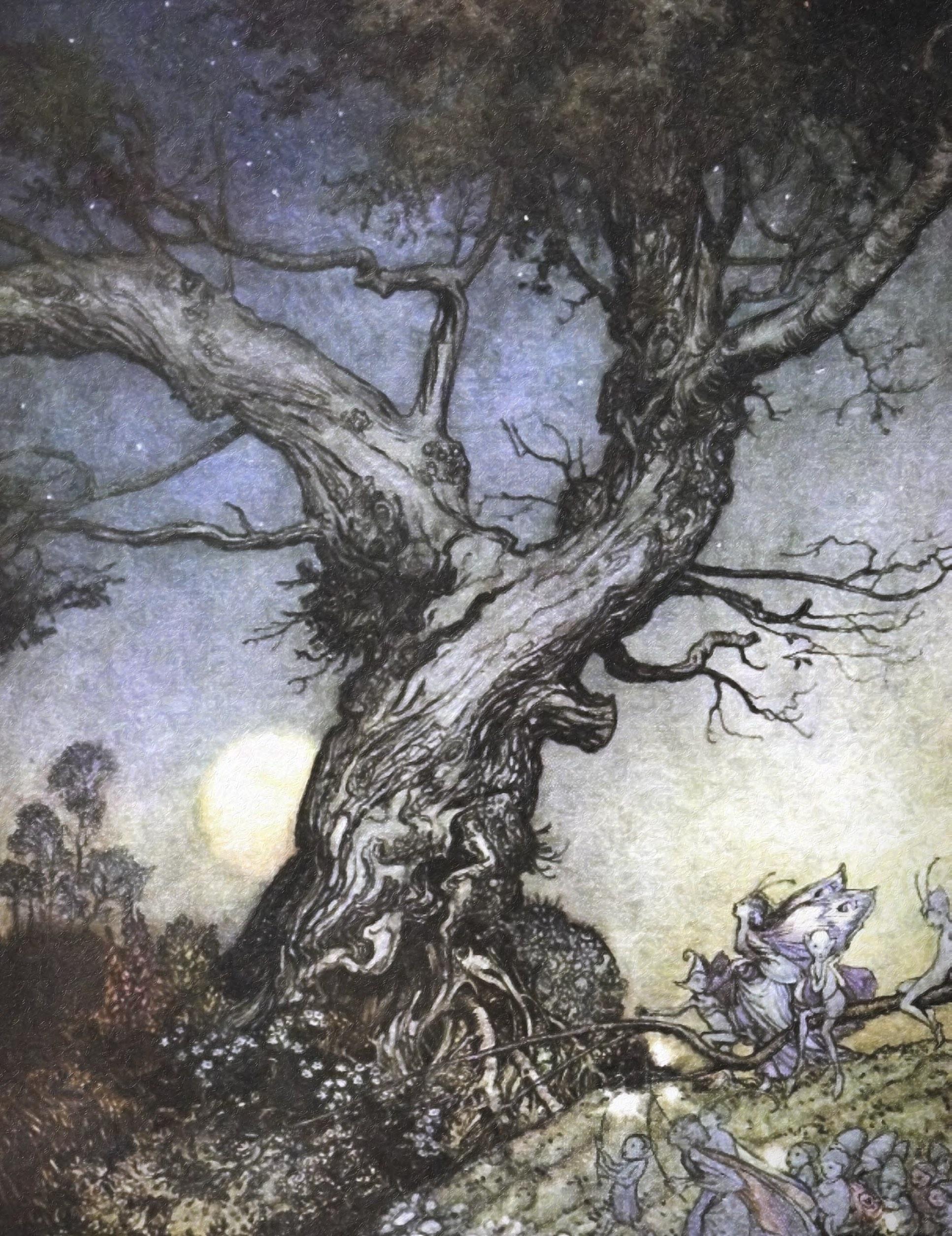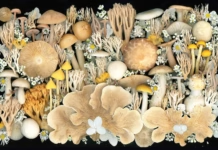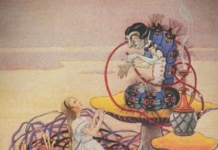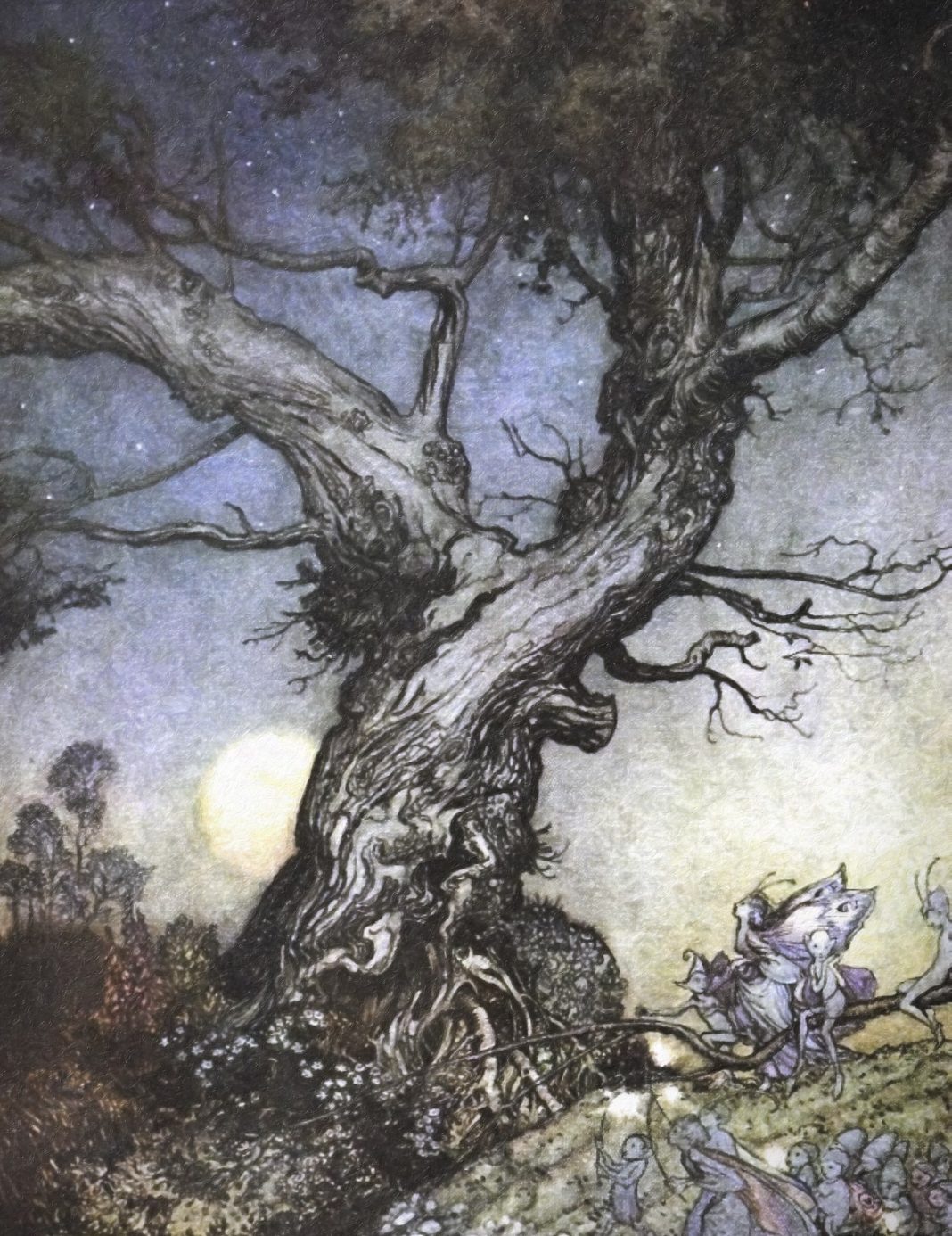My grandmother was a mysterious woman—quiet and stern, her burdens etched harshly across her face. Her home was unremarkable, uncluttered, and as sensible as the black-soled shoes she always wore. Grandmother didn’t have a chest filled with toys or a dress-up box for young visitors to explore on visits to her home. And you never asked her for a cookie but always waited for her to offer, and those offerings were few and far between. But when Grandmother took one of us for a walk among her treasured trees of the woodland that kept her property enchantedly wild, she changed. Her steps lightened, and the lines that told a story of a life filled with hardship faded. She was frolicsome, and it was in that forest that I saw in her the girl she was meant to be.
“Over here, child,” she motioned, always three steps ahead of me. “Say hello to this fine elder who protects your grandmother from what’s beyond the veil.”
“Hello, Elder,” I said, stroking the mottled gray bark, whose ghostly demeanor beckons to me even now. “Can I ask you a question, Grandma?”
“Of course, child. But be careful of the Bleeding Heart” she warned, as I stumbled over moss-coated roots that rose from beneath the forest’s debris.
“Why do you tie things in that tree?” I pointed to what I know now as an Elder. The tree wore the blush of spring’s new green and was covered with milky white flowers and several bright red cloth strips tied loosely in her branches.
Grandmother was still for a moment. “Those are my prayers, child,” she said and placed a basket just below the Elder’s small trunk.
I watched as she bowed before the tree and mumbled indiscernibly. She was quiet as she worked, picking blossoms that I recognized as an ingredient in a tea she always made.
As this ritual played out, the forest grew quiet and I remember hearing only the soft dropping of the blooms into the basket and my own breath. When she was finished, she grabbed my hand and spoke to me of the old ways and of the wizened Elder Mother who resided within the tree. We walked slowly back to her home.
“When I die someday,” she said. “I will become a tree. For that,” she pointed to her unadorned little house, “is not my home. I belong to the trees.”

The Elder Tree
If you’re walking near the hedgerow on an evening when the air is tinged with the scent of woodbine and the breeze ruffles your magical senses, and you pass an elder tree, don’t forget to tip your hat in respect for the wizened woman, Elder Mother, who resides within. She is the crone of winter whose lessons can be gleaned from the rise of smoke of the communal fire and frost patterns on leaves. She is the aspect of the spirit that draws us inward, so we can gather our energy and eventually blossom. To our ancient relatives the elder tree was surrounded by taboo and was approached with caution and ritual. No forester would dare take from the lady tree before asking:
Owd Girl, give of thy wood,
An’ I will give thee some of mine,
When I become a tree.
The Elder Mother was thought to be connected to the White Goddess of Winter, who was known as Hel or Hella in Scandinavian lore, Holda or Bertha in Germanic mythology, or Holde on the British Isles. She is the goddess of rejuvenation and transformation. She is the dark mother who holds our hand as we look deep into the cauldron of our soul, knowing that only by manifesting metaphorical death can rebirth begin.
The elder tree is a small tree that grows along country paths and along hedgerows. The European elderberry (Sambucus nigra) grows taller (up to twenty feet) than its American cousin (Sambucus canadensis), but both bear clumps of sweet-smelling white flowers in the spring and deep blue berries that hang in massive clumps during the late summer and early autumn months. There is also a red variety (Sambucus racemose) that produce berries that are slightly toxic, and of course, there are many other cultivars available at your local nursery or garden center that have been hybridized as ornamental shrubs or for maximum fruit production.
This bent but formidable tree that imbues the magic of the crone leads us through the dark half of the year in more ways than one. The berries of the elder tree that are harvested in early fall are rich in vitamin C and chemical compounds called anthocyanidins, which makes syrups and tea that can be a powerful medicine for combating wintertime colds and flus. Infusions made of the flowers in late spring can be used to ease head colds and can be used as a gargle for sore throats. It may also relieve the symptoms of ailments such as bronchitis, fever, and gout. The bark is a strong diuretic and was used in ancient times as a purgative in cases of food poisoning. Leaves can be used as a poultice for inflammation, and the young shoots to clear phlegm from the lungs and head.
Elder guards the gateway to the otherworld. To meditate under her branches brings you closer to the land of fae. In fact, it is said that if one takes in the fragrance of the elder’s blossoms on May eve, you will see the fairy king and his entourage. For communication with the otherworld, play a flute or whistle made from the wood of the elder. And for the rest of us who are not adept at making woodwind instruments, sit quietly under the branches and gently ring a bell three times before meditating. This will not only clear away the negativity, but it will also draw the fae to you.
Elder guards against negativity. Plant an elderberry in your garden to protect your property and to enjoy its delicious and healthful fruit. Wands made from elder can be used to dispel negativity and in spells for healing, prosperity, exorcism, and protection.
The use of elder flowers at weddings was thought to bring good fortune to the newly married couple, and elder leaves were once carried to help one avoid adulterous temptations.
My daughter was only three years old when my grandmother passed on. Every spring after her passing, just as spring ignites, spreading its green fire throughout the woodland, we bring a basket and bow to the Elder. “Hello, Grandmother,” I say. “I miss you and would appreciate it if we could take a few blossoms for tea. And, Grandmother,” I say as I tie a silken ribbon loosely around a branch, “I promise to give back when I become a tree.”
Grandmother’s Elderflower Tea
2 parts dried elderflowers
1 part dried chamomile
½ part dried nettle
This sweet and slightly earthy tea blend harnesses all the goodness of spring along the forest’s edge. Place tea in a tea ball and drop into your favorite mug. Pour boiling water into mug, cover, and let steep for five minutes. Remove tea ball and enjoy. Add honey or cream to taste.

































